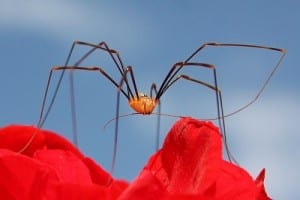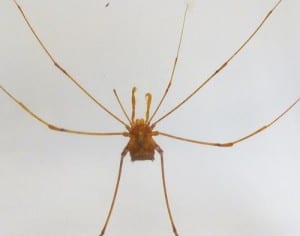Specimen of the Week 192: The Harvestman
By zcqsrti, on 15 June 2015
Case 11: the final resting place of those that once scuttled and dashed between the shadows. Many eagerly feature in our lives, brushing softly against the unaware’s skin, only to dart off as they are noticed, leaving a split second image of many a shambling leg to return as a parting gift at night when the lucidity of dreams kick in. Staring out from the dim stillness a dour creature resides, and an eternal watch it holds.
It was at first the near-symmetry of this specimen that drew me to it while bumbling around the Grant Museum; but after doing a little research, only then did it become apparent that this creature is far deserving of a week-long bask in the limelight. These critters are easily mistaken for spiders, both having eight spindly legs, but in fact they are far cuter, and much to the ire of arachnophobes. Many aspects of their biology and their cultural influence make them the spider’s rather well-appreciated cousin, and rightfully so.
So thus begins my job to convince you, dear literary companion, of this creature’s cause, lest it be cast off back to the tenebrous corners where the resting beasts of Case 11 do creep and surge. This week’s Specimen of the Week is…
**The Harvestman**
-Harvestmen make up the third largest order of arachnids, the Opiliones, which comprises over 6500 described species to date. As is often the case with invertebrates, species are still being discovered and it is thought that the actual species number could be well beyond 10000. Harvestmen have a wide distribution and are found in every continent except Antarctica (plenty to go around, no need to jostle). Fossils of a great similarity to modern harvestmen are known that date back to the Early Devonian 400 million years ago; they are truly good at what they do and in all that time their body plan has hardly changed… after all, why fix it if it ain’t broke?.
-Similarities between the Opiliones and spiders stop at the legs, quite literally, given that the harvestman’s body is made up of apparently single unit, whereas in spiders the body is separated into the cephalothorax (the front bit, made up of the head and thorax) and the abdomen (the back bit). In truth, the body of a harvestman is still separated, only that the join between the cephalothorax and the abdomen is wider, giving their body its characteristic oval shape. Harvestmen are also lacking in the web spinning department and do not have a spinneret with which to produce silk, unlike the spiders, which (as is commonly recognised) are significantly un-lacking in the web-spinning department.
-Harvestmen sometimes exhibit gregarious (or social grouping) behaviour, forming massive temporary colonies, of which have been recorded to be over 70000 strong. These aggregated clumps are typically found in the overhangs of rocks and within the joints of trees. By lifting their skinny legs to the heavens, harvestman groups can form an insulative layer to divert the flow of wind and conserve moisture. This display is adorable, albeit a little creepy and probably more comparable to a seething mess.

Harvestman (Opilio canestrinii) by Charlesjsharp.
Creative Commons Attribution-Share Alike 3.0 Unported
-Harvestmen are wonderfully caring fathers, in fact, the first recorded example of paternal investment in arachnids belongs to that of the neotropical species Zygopachylus albomarginis. This father builds an open-topped mud nest in which he guards fertilised eggs. Over the course of his life, he will graciously tend to this nest, keeping it clean from fungal infection and repairing it if needs be. This species also has a complex courtship ritual in which a female selects a suitable well-kept nest and dances by leg tapping with its owner before fertilisation. Strangely, as if in protest, nature has balanced all this charmingness out, since this species also readily expresses egg cannibalism (but we’ll be setting that mishap aside because I want to make them seem cute).
-Finally, a harvestman features in Salvador Dali’s painting Daddy Longlegs of the Evening- Hope, a work bridging both Dali’s surrealist and classical periods. Painted in 1940, this grim piece reflects the apocalyptical landscape and ongoing horrors of WWII that Dali escaped from. Holding steady at the centre, swarmed by ants and missing a leg (just like this specimen), is a harvestman, symbolising hope amidst the rampant decay. This symbolism emanates from an old French peasant legend that the sighting of a harvestman during the evening brings good fortune. Interestingly, this isn’t the only folklore to suggest that harvestman were once considered a good omen; in Turkish its common name, ‘mῡfdeci’, translates as a ‘person who brings good news’.
Rowan Tinker is Visitor Services Assistant at the Grant Museum of Zoology, and a UCL Natural Sciences student.
3 Responses to “Specimen of the Week 192: The Harvestman”
- 1
-
2
Spiderday (the eighth) | Arthropod Ecology wrote on 20 June 2015:

[…] the Grant Museum the “Specimen of the week” is an Opiliones. Lovely critters – and cousins to the other […]
-
3
Who are you calling a Spider? | ZOO*3700's Blog wrote on 4 October 2016:

[…] https://blogs.ucl.ac.uk/museums/2015/06/15/specimen-of-the-week-192-the-harvestman/ […]
 Close
Close




Fascinating article, amazing animal behaviour